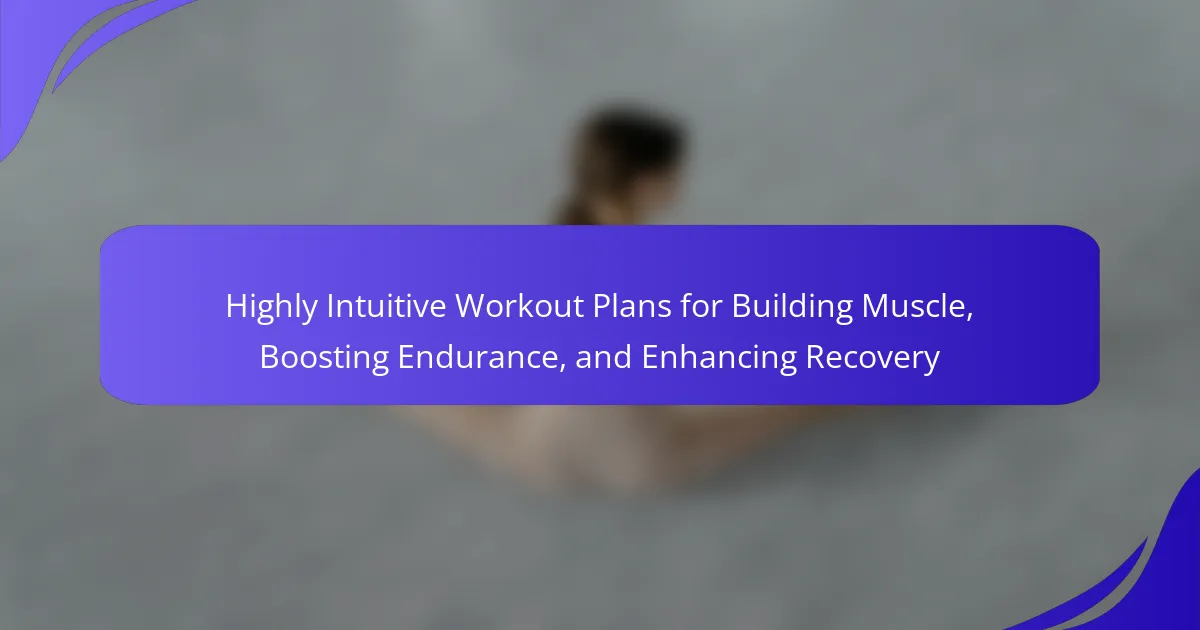Building muscle, boosting endurance, and enhancing recovery are essential goals for fitness enthusiasts. Highly intuitive workout plans achieve these objectives through personalization, progressive overload, and effective recovery strategies. They adapt to individual fitness levels, incorporate varied exercises, and integrate recovery techniques. This approach fosters engagement and prevents plateaus, ensuring optimal performance and motivation.

What are the key components of highly intuitive workout plans?
Highly intuitive workout plans focus on personalization, progressive overload, and recovery strategies. These plans adapt to individual fitness levels, preferences, and goals, ensuring engagement and effectiveness. Key components include structured variations, clear progression metrics, and integrated recovery protocols. Personalization enhances motivation, while progressive overload drives muscle growth and endurance. Recovery strategies prevent burnout and injuries, promoting overall performance.
How do these plans support muscle building?
Highly intuitive workout plans support muscle building by incorporating progressive overload, varied exercises, and tailored nutrition strategies. These plans emphasize the importance of challenging muscles consistently to stimulate growth. Key attributes include structured strength training sessions, optimal recovery periods, and specific macronutrient distribution. Research shows that plans with a focus on compound movements can enhance muscle hypertrophy significantly. Additionally, tracking progress and adjusting intensity ensures continued adaptation, maximizing muscle gains over time.
What strategies enhance endurance through workout plans?
Structured workout plans enhance endurance through progressive overload, varied intensity, and recovery strategies. Incorporating interval training, strength sessions, and active recovery days fosters stamina and resilience. Consistency in training frequency and proper nutrition supports these efforts, optimizing performance. Tailoring workouts to individual goals and fitness levels ensures effective endurance building.
How can recovery be optimized in workout routines?
To optimize recovery in workout routines, prioritize sleep, nutrition, hydration, and active recovery techniques. Adequate sleep enhances muscle repair and growth. Consuming a balanced diet rich in protein supports recovery processes. Staying hydrated aids in nutrient transport and muscle function. Incorporating active recovery, such as light exercises or stretching, promotes blood flow and reduces soreness.

What universal principles define effective workout plans?
Effective workout plans prioritize progression, variety, and recovery. These principles ensure muscle growth, enhanced endurance, and improved recovery.
Progressive overload is crucial; gradually increasing weight or intensity leads to muscle adaptation. Variety prevents plateaus by incorporating different exercises and training modalities. Recovery is essential; adequate rest and nutrition optimize performance and muscle repair.
Integrating these principles fosters a balanced approach, enhancing overall fitness and performance.
How does personalization improve workout effectiveness?
Personalization significantly enhances workout effectiveness by tailoring plans to individual needs. Customized workout plans consider unique attributes such as fitness level, goals, and recovery time, leading to more efficient muscle building and endurance boosting. As a result, individuals experience improved motivation and adherence to their routines, maximizing overall performance. Personalized plans can adapt over time, ensuring continued progress and preventing plateaus.
What role does progressive overload play in muscle building?
Progressive overload is crucial for muscle building as it stimulates growth by gradually increasing workout intensity. This principle ensures muscles continually adapt, leading to enhanced strength and size over time. Regularly adjusting weights, repetitions, or workout volume creates consistent challenges, preventing plateaus. For instance, increasing weights by 5% every few weeks can effectively promote muscle hypertrophy.
Why is periodization essential for endurance training?
Periodization is essential for endurance training because it optimizes performance and reduces injury risk. By structuring training into phases, athletes can balance intensity, volume, and recovery. This approach enhances adaptation, allowing for peak performance during competitions. Studies show that periodized training leads to significant improvements in endurance metrics compared to non-periodized methods.

What unique attributes distinguish highly intuitive workout plans?
Highly intuitive workout plans distinguish themselves through their adaptability, personalization, and focus on holistic progress. These plans adjust based on individual performance metrics, ensuring optimal muscle building, endurance boosting, and recovery enhancement.
Unique attributes include real-time feedback mechanisms that track user responses and adjust intensity accordingly. Additionally, they often incorporate varied workout modalities, promoting engagement and preventing plateaus. The integration of recovery techniques, such as active rest days and mobility work, further enhances overall effectiveness.
As a result, users experience not only improved physical outcomes but also heightened motivation and adherence to their fitness regimes.
How do feedback mechanisms enhance workout adaptability?
Feedback mechanisms enhance workout adaptability by providing real-time insights into performance and recovery. They allow individuals to adjust their routines based on progress, ensuring optimal muscle growth and endurance. For instance, tracking fatigue levels can guide rest days, while monitoring strength improvements can inform load increases. This personalized approach fosters a unique training experience, maximizing results and minimizing injury risk.
What innovative techniques are used for recovery enhancement?
Innovative techniques for recovery enhancement include active recovery, cryotherapy, and personalized nutrition plans. Active recovery involves low-intensity exercises that promote blood flow and reduce muscle soreness. Cryotherapy utilizes extreme cold to decrease inflammation and expedite healing. Personalized nutrition plans focus on specific dietary needs to optimize recovery, ensuring adequate protein intake and nutrient timing. These methods significantly improve recovery outcomes, allowing for better performance in subsequent workouts.

What rare features can elevate workout plans for men?
Incorporating rare features can significantly enhance workout plans for men. Unique recovery techniques, such as cryotherapy, can reduce muscle soreness and improve performance. Personalized nutrition strategies, tailored to individual metabolic responses, optimize muscle gain and endurance. Advanced tracking technologies, like biometric wearables, provide real-time feedback, enabling precise adjustments. Lastly, incorporating unconventional training methods, such as animal flow or aerial yoga, can engage different muscle groups and prevent plateaus.
How does incorporating technology improve workout tracking?
Incorporating technology enhances workout tracking by providing precise data and insights. Wearable devices and apps monitor metrics like heart rate, reps, and recovery time, enabling personalized adjustments. Real-time feedback fosters motivation and accountability. Advanced analytics facilitate progress tracking, ensuring workouts align with muscle-building, endurance-boosting, and recovery-enhancing goals.
What exclusive methodologies exist for boosting motivation?
Creating high motivation levels can be achieved through exclusive methodologies tailored to workout plans. Techniques such as goal setting, visualization, and progress tracking can significantly enhance commitment.
Goal setting involves defining specific, measurable, achievable, relevant, and time-bound objectives that provide clear direction. Visualization techniques allow individuals to mentally rehearse their success, reinforcing motivation. Progress tracking through apps or journals offers tangible evidence of improvement, fostering a sense of accomplishment.
Incorporating these methodologies into highly intuitive workout plans can lead to better muscle building, improved endurance, and enhanced recovery. Consistent application of these strategies creates a positive feedback loop, sustaining motivation over time.

How do cultural factors influence workout preferences?
Cultural factors significantly shape workout preferences by influencing attitudes, values, and social norms. For example, in collectivist cultures, group workouts may be favored, promoting camaraderie and support. In contrast, individualistic cultures might emphasize personal achievement and tailored workout plans. Additionally, cultural beliefs about body image and fitness can dictate preferred workout styles and intensity levels. Understanding these influences helps in designing highly intuitive workout plans that cater to diverse preferences, enhancing muscle building, endurance, and recovery.
What common misconceptions exist about muscle building strategies?
Many misconceptions about muscle building strategies can hinder progress. One common myth is that lifting heavier weights is the only way to build muscle. In reality, varying rep ranges and focusing on form can also stimulate growth. Another misconception is that muscle building requires excessive protein intake; however, balanced nutrition with adequate protein suffices for most individuals. Additionally, some believe that longer workouts are more effective, but shorter, intense sessions can yield better results. Lastly, many think that muscle soreness equates to an effective workout, yet recovery is equally crucial for muscle growth.
How do dietary habits affect workout success?
Dietary habits significantly influence workout success by providing essential nutrients for muscle growth, endurance, and recovery. A balanced intake of proteins, carbohydrates, and fats optimizes performance and enhances recovery. For instance, protein intake supports muscle repair, while carbohydrates fuel workouts. As a result, individuals who prioritize nutrition often experience improved results in their fitness routines.
What are the best practices for integrating recovery into training?
Integrating recovery into training involves structured practices that enhance muscle growth and endurance. Prioritize rest days to allow muscle repair, as recovery is crucial for performance. Implement active recovery sessions, such as light cardio or stretching, to maintain circulation and flexibility. Incorporate nutrition strategies, focusing on protein intake post-workout to support muscle synthesis. Lastly, ensure adequate hydration to optimize recovery processes and prevent fatigue.
What common mistakes should be avoided in workout planning?
To avoid common mistakes in workout planning, focus on specificity, progression, and recovery. Many individuals fail to set clear goals, leading to ineffective routines. Additionally, neglecting to adjust intensity or volume can hinder muscle growth and endurance. Overlooking rest days can also impede recovery, resulting in burnout or injury. Lastly, ignoring nutrition’s role in supporting workout objectives limits overall effectiveness.
How can consistency be maintained in workout routines?
To maintain consistency in workout routines, establish a structured plan that includes varied exercises, progressive overload, and scheduled rest days. This approach promotes muscle building, boosts endurance, and enhances recovery.
Incorporating tracking tools can provide insights into progress, helping to adjust routines as needed. Additionally, setting specific goals can motivate adherence to the plan. Consistency is further supported by creating a workout schedule that fits personal lifestyle, ensuring workouts become a regular part of daily life.



